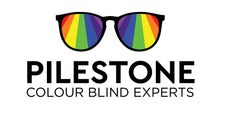Colour Blind Glasses Lens Guide
Pilestone has developed 5 unique lens types and you may be wondering which one to choose? In this simple color blind lens guide, we're going to run you through each lens type to ensure you choose the best option.
Take our world class color blind test now and find the lens type that's best for you.
Lens A (Universal, Indoor & Outdoor)
This lens is universal, meaning it is equipped with the necessary technology for deutan and protan color blindness (red-green blindness). People with mild/moderate color blindness typically show the best results from this lens.
Lens B (Universal, Indoor & Outdoor)
Our most popular and effective lens for most users especially for bright outdoor scenic locations. Similar to lens A, but has a darker tint to the lens. Our lens B is universal and therefore developed for people with deutan and protan color blindness (red-green blindness). People with strong/severe color blindness typically show the best results from this lens.
Lens C (Indoor lens)
Designed specifically for lower lighting conditions. People that need color blind glasses primarily for indoor use will benefit most from this lens. Recommended for those with mild/moderate and strong deutan (red-green blindness).
Lens D (Protan color blindness)
Lens D is designed for those with protan color blindness (red blindness). People with strong/severe protan color blindness typically show the best results from this lens.
Lens E (Tritan color blindness, Indoor & Outdoor)
Designed specifically for those who suffer from tritan color blindness. Tritan color blindness affects the blue-yellow color spectrum.
There are three main types of color blindness that Pilestone glasses can dramatically improve.
Deuteranomaly/Deuteranopia or otherwise more commonly known as 'red-green' color blindness. This type of color blindness is the most common and can affect a broad spectrum of colors including reds, greens, browns, oranges, blues, purples, pinks, and yellows.
Protanomaly/Protanopia - this is a less common sub-type of red-green color blindness and mostly affects reds more than greens.
Tritanomaly/Tritanopia - This is a very rare type of color blindness and affects only 1 in every 100 people that suffer from color blindness. Tritan color deficiency affects the blue-yellow spectrum.


